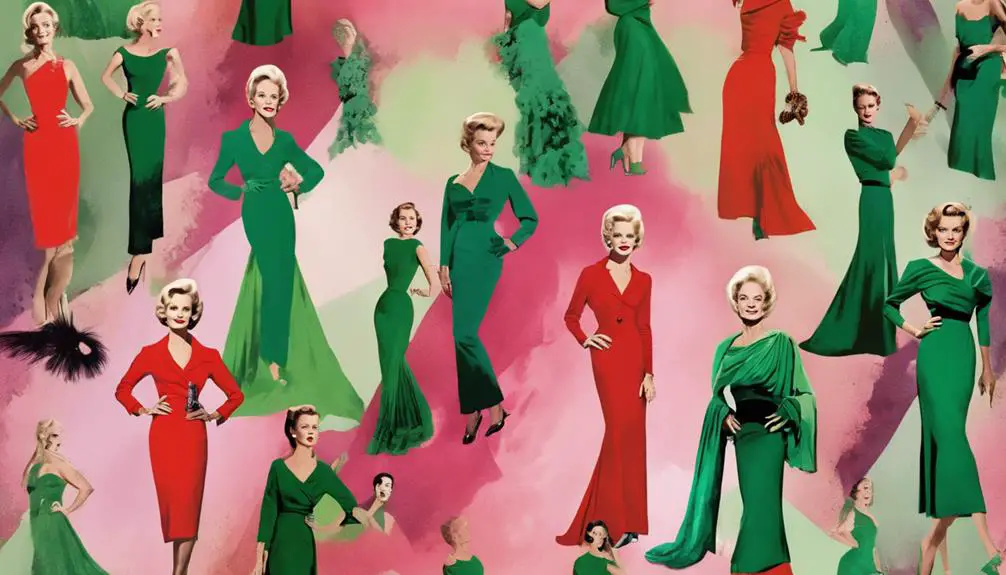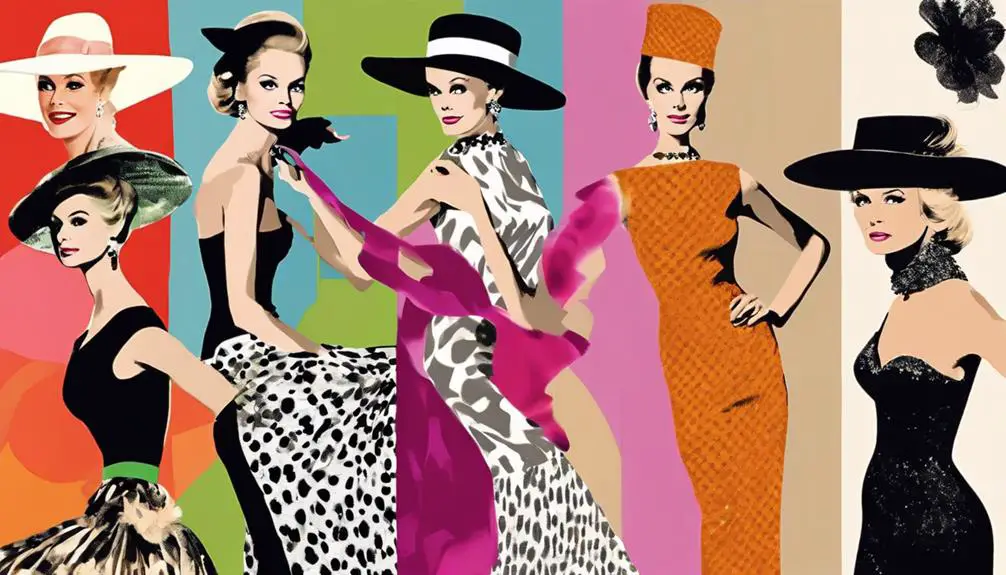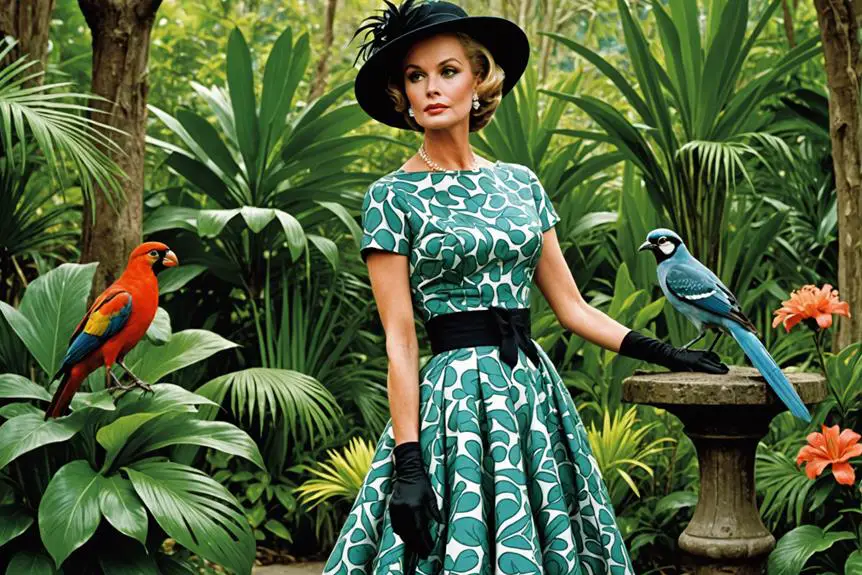When you think about Tippi Hedren, her fashion choices often come to mind, reflecting a unique blend of elegance and boldness that shaped her legacy. You might recall the striking green suit from "Marnie," a piece that not only defined her character but also made a lasting impact on cinematic style. As you explore her wardrobe, consider how each outfit tells a story and reveals deeper layers of her persona. What do these choices say about the evolution of fashion in Hollywood, and how do they resonate with today's trends?
Tippi Hedren's Fashion Legacy

Tippi Hedren's fashion legacy is nothing short of iconic, resonating with both film lovers and fashion enthusiasts alike. You've likely seen her stunning looks in movies like "The Birds" and "Marnie," and let me tell you, it's hard to forget. With the brilliance of costume designer Edith Head, Tippi rocked some seriously elegant outfits that defined Hollywood elegance in the 1960s and 70s.
Her wardrobe wasn't just about looking good; it told a story. Those mesmerizing green ensembles in "Marnie"? They weren't just pretty dresses; they represented her character's psychological depth and transformation. Isn't it amazing how a color can convey so much? You can see how Tippi's outfits helped shape her iconic roles, making them unforgettable.
But it doesn't stop there. Tippi's fashion moments on the red carpet showcased her classic style, and you can still spot her influence today. Designers and fashion enthusiasts are often inspired by her looks, proving that her legacy extends beyond the silver screen. When you think of timeless fashion, Tippi Hedren is a name that pops up, and rightly so!
Memorable Outfits From "Marnie"
When you immerse yourself in "Marnie," you'll quickly notice how each outfit plays an essential role in revealing the character's complexities. Tippi Hedren, in her stunning wardrobe designed by Hitchcock, brings Marnie Edgar to life through fashion that mirrors her psychological struggles. Take that striking green suit she wears during the pivotal robbery scene. It's not just a pretty outfit; it symbolizes her internal duality—she's both a thief and a woman hiding her trauma.
Then there's the casual elegance of the tan high-waisted slacks and yellow sweater she dons for horseback riding. It's like she's trying to blend in, yet you can sense something's off. That darker green suit she wears while visiting her mother? It's a powerful reflection of her internal conflict and a nod to her traumatic childhood. You can almost feel the weight of her past in those moments.
And let's not forget Marnie's wedding attire—a tan suit with fur accents. It's a statement of her shift into high society, but there's still a hint of her personal demons lurking beneath the surface. Throughout the film, her muted blouses and sweaters enhance her low-profile demeanor, perfectly matching her chaotic life of theft and turmoil.
Impact of Color in Costume Design

Costume design plays a pivotal role in shaping the emotional landscape of a film, and color choices are particularly powerful in this regard. Just think about Tippi Hedren's wardrobe in Alfred Hitchcock's "The Birds." The standout color? Green! Designed by the legendary Edith Head, her green wool sheath dress tells a story all on its own. It not only captures the mid-century fashion vibe but also symbolizes Hedren's character's transformation throughout the film.
Imagine this: Hedren, dressed in vibrant green, strutting through the muted colors of Bodega Bay. That contrast really makes her pop, doesn't it? It's like she's an outsider in this eerie world, and the color adds so much tension to the story. You can feel the unease and allure just by looking at her outfits. The green suits her journey, enhancing the film's emotional depth and making you think about her struggles.
Plus, those costumes aren't just pretty pieces; they're iconic! The way color enhances character portrayal is truly remarkable. When you see that green dress, you can't help but feel something. The choice of color can drive the story and connect you to the characters on a deeper level. So, next time you watch a film, pay attention to those colors in the wardrobe. They're not just there for looks—they're telling you a whole story!
Accessories and Their Significance
Sophistication and elegance often shine through the careful selection of accessories, and Tippi Hedren's wardrobe is a perfect example. When you think about her iconic looks in films like "Marnie" and "The Birds," it's hard not to notice how those accessories play a vital role. Take her gloves and scarves, for instance. They weren't just there for decoration; they added layers of sophistication that really elevated her characters.
Now, let's talk pearls. Hedren often wore multi-strand pearl jewelry, which not only highlighted her character's wealth but also symbolized femininity and refinement during the 1960s. Pretty cool, right? In "Marnie," her green handbag and matching gloves weren't just stylish; they amplified the symbolism of her character's struggles, making the story even richer.
And who could forget that iconic tan trench coat? Wearing it while job searching, she blended practicality with chic elegance, reflecting the fashion trends of her time. It's amazing how one piece can say so much!
Hitchcock knew what he was doing with costume design, and Hedren's accessories were integral to the storytelling. They helped you understand her character's journey and emotions without a single word. So, next time you're picking out your outfit, remember: the right accessories can transform your look and tell your own story! Why not channel a bit of Tippi's elegance in your own style?
Evolution of Hedren's Style

Tippi Hedren's style reflects a fascinating journey through the decades, showcasing her evolution from classic Hollywood glamour to a more tailored sophistication. Can you imagine her in that stunning eau de nil suit designed by Edith Head, Hollywood's Greatest Costume Designer? It's a look that perfectly captures the elegance of the 1960s, especially in films like "The Birds" and "Marnie." Those green hues were more than just colors; they symbolized her characters' complexities and alterations. During this era, scarves emerged as essential accessories, much like Hedren's own choices, solidifying their place as bold fashion statements that signified sophistication and individuality in men's fashion, as seen in the 1930s Men's Scarves Evolution.
As you explore Hedren's wardrobe, you'll notice how her signature looks changed over time. She embraced structured suits and elegant dresses, creating a chic, streamlined silhouette that defined mid-century fashion trends. Isn't it amazing how her style reflects her personal growth and the changing societal norms around her?
Accessories, like gloves, pearls, and scarves, played a crucial role too, enhancing her sophisticated image while signaling her character's social status in those Hitchcock films. With a career spanning over 55 years, Hedren's fashion choices have influenced modern trends. Vintage enthusiasts often look to her iconic looks as a style guide, don't you think?
Frequently Asked Questions
What Was Tippi Hedren Famous For?
Tippi's early career launched her into Hollywood stardom, showcasing her personal style and fashion influence. Beyond acting, she committed to animal activism, leaving a lasting legacy that continues to inspire future generations in both fields.
What Did Tippi Hedren Wear in the Birds?
Like a painter's brushstroke, Tippi's costume design in "The Birds" showcases character symbolism through a striking color palette. Her vintage style, featuring iconic outfits, profoundly influences fashion, capturing Marnie's complex journey and transformation.
How Did Hitchcock Treat Tippi Hedren?
Hitchcock's manipulation created on-set tension, drastically impacting your career. His possessive behavior led to psychological effects that echoed in your life, yet you displayed personal resilience, ultimately crafting a lasting fashion legacy despite the challenges.
What Happened to Tippi Hedren While Filming the Birds?
While filming "The Birds," you faced intense filming challenges, enduring real bird attacks that tested your resilience. The lack of on set safety during iconic scenes shaped not only your experience but also the movie's legacy.




